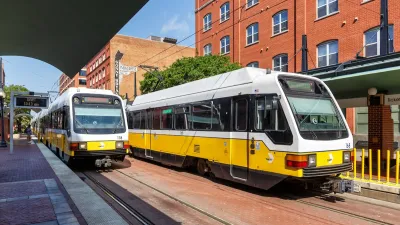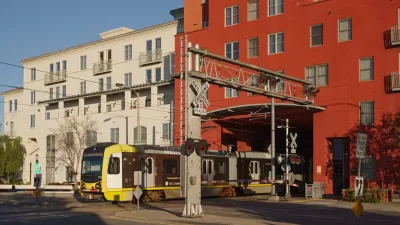For residents of many U.S. small towns and exurbs, the local Walmart offers a surprising benefit missing elsewhere in their communities: walkability.

Writing in Discourse Magazine, Addison Del Mastro compares the layout of a typical superstore with a traditional historic downtown, and finds some surprising similarities. While the vast majority of Walmarts and their ilk are located in car-oriented communities surrounded by seas of parking, their interior layouts oddly mirror the grid of a classic small town, Del Mastro writes.
“The idea of a commercial space aping the design of a city is somewhat familiar when it comes to the suburban shopping mall. Malls were famously designed after urban downtowns or shopping districts by the European-born architect Victor Gruen, who envisioned them not as churches of consumerism but as weather-free, and traffic-free, diminutive cities.” (More on that in Alexandra Lange’s book, Meet Me by the Fountain: An Inside History of the Mall.)
Walmart replicated this at massive scale. “And so what the big-box discount department store effectively did was consolidate and transpose almost every classic Main Street enterprise—clothing, toys, crafts, decor, electronics, hardware and groceries —and place them all under one roof, under one corporate enterprise, in a massive, car-oriented property on the edge of town.”
For Del Mastro, the car-free aspect is the most interesting. “By segregating the cars completely outside and making the ‘streets’ car-free—something often deemed suspect or radical when attempted in actual cities—the shopping experience becomes safer and more convenient to the customer.”
Ultimately, there is an important lesson to be learned from the behemoth often credited with killing small town economies. “If we could transpose the commercially vibrant walkability of a modern Walmart back to the downtowns it killed, those towns would be better off.” This shows that “despite the political framings and stereotypes around transportation and land use issues, the desirability of commerce in a walkable setting transcends political lines.” When stripped of its political baggage, people just like walkability.
FULL STORY: Walmart Didn’t Kill the Small Town, It Is the Small Town

Alabama: Trump Terminates Settlements for Black Communities Harmed By Raw Sewage
Trump deemed the landmark civil rights agreement “illegal DEI and environmental justice policy.”

Study: Maui’s Plan to Convert Vacation Rentals to Long-Term Housing Could Cause Nearly $1 Billion Economic Loss
The plan would reduce visitor accommodation by 25% resulting in 1,900 jobs lost.

Why Should We Subsidize Public Transportation?
Many public transit agencies face financial stress due to rising costs, declining fare revenue, and declining subsidies. Transit advocates must provide a strong business case for increasing public transit funding.

Wind Energy on the Rise Despite Federal Policy Reversal
The Trump administration is revoking federal support for renewable energy, but demand for new projects continues unabated.

Passengers Flock to Caltrain After Electrification
The new electric trains are running faster and more reliably, leading to strong ridership growth on the Bay Area rail system.

Texas Churches Rally Behind ‘Yes in God’s Back Yard’ Legislation
Religious leaders want the state to reduce zoning regulations to streamline leasing church-owned land to housing developers.
Urban Design for Planners 1: Software Tools
This six-course series explores essential urban design concepts using open source software and equips planners with the tools they need to participate fully in the urban design process.
Planning for Universal Design
Learn the tools for implementing Universal Design in planning regulations.
Caltrans
Smith Gee Studio
Institute for Housing and Urban Development Studies (IHS)
City of Grandview
Harvard GSD Executive Education
Toledo-Lucas County Plan Commissions
Salt Lake City
NYU Wagner Graduate School of Public Service




























